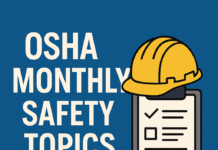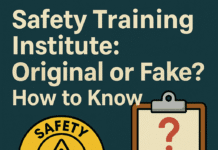
What is the OSHA Standard for Working at Height?
Introduction
OSHA Standard for Working at Height : In the world of construction and various industrial works, working at height is a common occurrence. It involves tasks performed at elevated levels, such as on ladders, scaffolds, rooftops, or platforms. While these jobs are essential for progress, they also pose significant risks to workers’ safety. To address these risks and ensure a safe working environment, the Occupational Safety and Health Administration (OSHA) has set standards specifically for working at height.
Understanding OSHA
The Occupational Safety and Health Administration, commonly known as OSHA, is a regulatory body within the United States Department of Labor. Its primary mission is to ensure the safety and health of workers by setting and enforcing standards, providing training, and offering education and assistance. OSHA plays a pivotal role in safeguarding employees from workplace hazards and is instrumental in reducing workplace injuries, illnesses, and fatalities.
Working at Height
Working at height encompasses any task performed above ground level. This can include jobs like roof repairs, installation, painting, window cleaning, or construction work on tall structures. While these activities are necessary, they come with inherent risks, making it crucial to follow safety guidelines and OSHA standards.
The potential risks involved in working at height are numerous. They range from falls due to unstable surfaces or lack of fall protection to accidents caused by improper use of equipment or inadequate training. Workers facing such hazards must be equipped with the necessary knowledge and tools to ensure their safety.
OSHA Standards for Working at Height
To mitigate the risks associated with working at height, OSHA has put in place stringent regulations. These standards focus on the use of protective equipment, safe work practices, and proper training. Employers are responsible for adhering to these guidelines and ensuring their employees have the resources to work safely.
One of the key requirements is fall protection. This can include guardrails, safety nets, or personal fall arrest systems. The specific measures depend on the height at which the work is being performed and the nature of the task. OSHA also mandates inspections and regular maintenance of equipment to ensure its reliability.
Complying with OSHA Standards
Both employers and employees play a crucial role in adhering to OSHA standards for working at height. Employers must provide adequate training, ensure the use of proper equipment, and maintain a safe work environment. Employees, on the other hand, must follow safety protocols, use protective gear, and report any hazards they encounter.
Regular inspections and risk assessments are essential to identify potential issues and rectify them promptly. Engaging workers in safety discussions and fostering a culture of safety within the workplace are also beneficial in promoting compliance.
Ensuring Worker Safety
Safety should always be a top priority for employers and workers alike. Implementing safety protocols is not just a matter of complying with regulations; it’s about valuing human lives and well-being. Companies with strong safety cultures tend to have more productive and motivated employees, leading to a positive impact on overall performance.
Ensuring worker safety requires open communication and a proactive approach to potential hazards. Encouraging workers to report unsafe conditions without fear of retribution fosters a sense of trust and responsibility.
Common Violations and Penalties
Despite strict OSHA standards, violations related to working at height continue to occur. Some common violations include failure to provide proper fall protection, inadequate training, and lack of safety equipment. OSHA takes these violations seriously and imposes penalties on non-compliant employers.
Penalties for violations can vary depending on the severity and frequency of the offense. They can range from monetary fines to temporary work stoppages or even criminal charges in extreme cases. Employers must be aware of these consequences and take every measure to avoid violations.
Conclusion
In conclusion, working at height is an essential aspect of various industries, but it comes with significant risks. Adhering to OSHA standards is vital to ensure the safety and well-being of workers involved in such tasks. Employers must provide proper training, equipment, and support to enable workers to perform their duties safely. Complying with OSHA regulations not only prevents costly penalties but also demonstrates a commitment to protecting the workforce. A safety-conscious workplace fosters productivity, employee morale, and ultimately, business success.
Frequently Asked Questions (FAQs)
FAQ 1: What is OSHA, and what is its role in workplace safety?
Answer: OSHA stands for the Occupational Safety and Health Administration, a regulatory body within the United States Department of Labor. Its primary role is to ensure the safety and health of workers by setting and enforcing standards, providing training, and offering education and assistance. OSHA plays a crucial role in reducing workplace injuries, illnesses, and fatalities through its enforcement of safety regulations.
FAQ 2: What does “working at height” mean, and what are some examples?
Answer: “Working at height” refers to any task or job performed above ground level. Examples include roof repairs, window cleaning, construction work on tall structures, installation, and maintenance on elevated platforms or scaffolds. These tasks involve potential fall hazards and require strict adherence to safety guidelines.
FAQ 3: What are the risks and hazards associated with working at height?
Answer: Working at height poses various risks and hazards to workers. The primary risk is falling, which can result from unstable surfaces, improper use of safety equipment, or lack of fall protection. Other hazards include objects falling from heights, exposure to extreme weather conditions, and the need to work near power lines.
FAQ 4: What are the OSHA standards for working at height?
Answer: OSHA has set stringent regulations for working at height to ensure worker safety. These standards include requirements for fall protection measures such as guardrails, safety nets, or personal fall arrest systems. Employers are also responsible for providing proper training, maintaining equipment, and conducting regular inspections.
FAQ 5: What are the penalties for violating OSHA standards related to working at height?
Answer: OSHA takes violations of working at height standards seriously and imposes penalties on non-compliant employers. Penalties can vary based on the severity and frequency of the violation. They may include monetary fines, temporary work stoppages, or even criminal charges in extreme cases. It is crucial for employers to be aware of these consequences and prioritize safety to avoid violations.
























